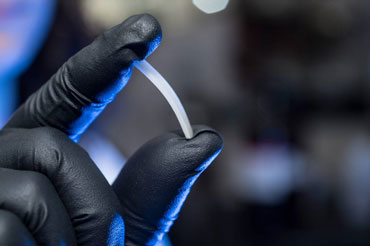What Can Be Recycled Again and Again
A new kind of plastic tin break down into the same building blocks from which it was made. Like a child'southward plastic Lego bricks, the molecular blocks can link and detach over again and again, a new study finds. And the cloth is more durable than earlier plastics designed to be recycled more than once.
Maybe you've learned to throw plastic bottles and containers into a recycling bin rather than the trash. News flash: Today, only about 10 percent of plastic ever gets recycled. That's according to a 2017 written report in Science Advances. Nearly of the rest lingers in landfills or ends up floating in the body of water. But plastic is then inexpensive and useful that hundreds of millions of tons more of it are made each twelvemonth.
Fifty-fifty plastic that does get recycled volition probable reach the landfill before long. That's because near plastics today don't turn back into their starting material. Instead, they break down into molecules that tin't be reused right away. Rather than pulling a Lego creation apart into its starting blocks, it might be more similar smashing the structure into bits.
Transforming those $.25, now, into something useable can take many chemical reactions. All that actress processing uses time, water and energy. Those steps brand recycling not very efficient. And few recycled plastics are remade into the aforementioned type of object they were before. Instead, most get turned into items such equally carpet, car parts and park benches — things that themselves are hard to recycle. But a plastic that could easily break downwards into its building blocks and be reused over and over? That could greatly help cut the global plastic-waste problem.
Explainer: What are polymers?
Michael Shaver is a pharmacist at the University of Edinburgh in Scotland. He studies plastics but wasn't function of the team that made the new fabric. Designing a reusable plastic is a balancing human action, he says. That's considering plastics are a type of polymer. Polymers are long chains of pocket-size molecules called monomers (MAH-nuh-merz). Those small starter molecules link together similar beads on a cord.
To be good for making polymers, the monomer building blocks should be fairly piece of cake to connect. Monomers that need extreme temperatures or too much chemical coaxing to link up might not be practical. What's more than, the end polymers tin can't be brittle or fall apart besides easily, Shaver notes. They need to be stable at a high enough temperature to exist used. Pouring a hot drinkable into a plastic cup? You don't want it to weaken the bondage and cook the loving cup into a sticky puddle.
Rigid and reversible
Polymer pharmacist Jianbo Zhu and his colleagues ready out to solve this challenge. They piece of work at Colorado State Academy in Fort Collins. The team previously made a polymer that could be broken down into its starting molecules. But the resulting plastics weren't usable. They were too soft and temperature-sensitive.

This new type of plastic material can break down into its original edifice blocks more easily than electric current plastics. It has the consistency of a disposable plastic bottle.
Bill Cotton/Colorado State Univ.
This time, Zhu and his colleagues started with one of their previous creations. The monomer's atoms were arranged in a ring shape. Then they added a 2nd ring of atoms in a style that braced the molecule into a rigid form. That rigidity helped the monomers link together. These quickly assembled into polymer bondage at room temperature. And the chains were stable fifty-fifty when heated upward. The team reported its results April 26 in Science.
Peculiarly important, the procedure was reversible. Certain balmy chemicals or really high heat broke the polymers apart. And they broke downwards into the same initial monomers. The researchers were able to repeat this cycle several times. Link, snap, link, snap. In theory, they say, the polymer could be infinitely recyclable.
The same chemic recipe tin brand either of two monomer shapes. Mixing the two monomers together created an even stronger plastic, reports Zhu.
"This is probably the all-time system out in that location," Shaver says.
Still, it's not perfect yet. Zhu and his colleagues program to go on tinkering with the monomer's design. They want the resulting plastic to be a bit less breakable. Anytime, they promise to have a product that can be sold.
rodriguezparend59.blogspot.com
Source: https://www.sciencenewsforstudents.org/article/plastic-can-be-recycled-over-and-over-and-over

0 Response to "What Can Be Recycled Again and Again"
Post a Comment